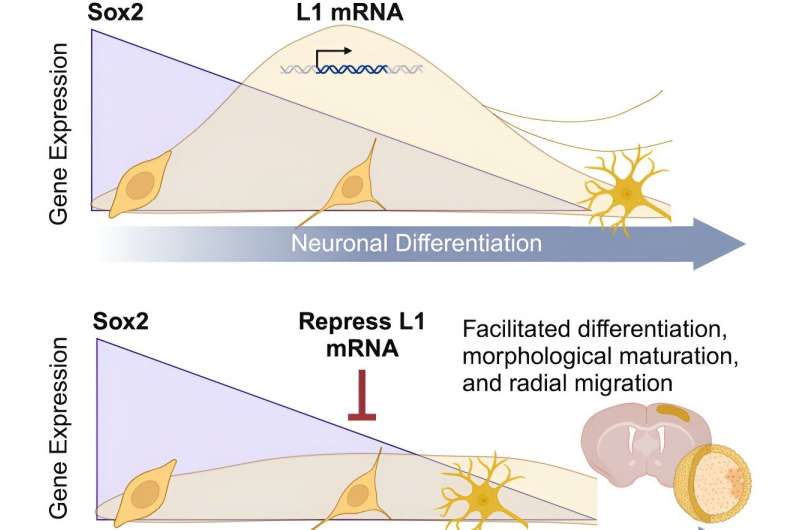This article has been reviewed according to Science X's editorial process and policies. Editors have highlighted the following attributes while ensuring the content's credibility:
fact-checked
peer-reviewed publication
trusted source
proofread
Previously ignored DNA sequence found to play important role in brain development

An international research team has discovered that a previously overlooked repetitive DNA element known as Long Interspersed Nuclear Element (L1) helps maintain neural progenitor cells, and thus plays an important role in mammalian brain development.
The study, published recently in the journal Cell Reports, was led by Tomohisa Toda, Professor of Neural Epigenomics at the Friedrich-Alexander-Universität Erlangen-Nürnberg (FAU), associated with the Max-Planck-Zentrum für Physik und Medizin, Erlangen, together with Professor Rusty Gage, Ph.D., at the Salk Institute, La Jolla, CA U.S.
The human genome provides the basic blueprint and circuit diagram to guide complex brain development. Depending on which genes are turned "on" or "off," cells proliferate and mature specifically into neurons or other brain cells. A complex interplay of genetic and molecular factors, which is still not completely understood, ensures that cells are generated, migrate, and mature at the correct times and locations.
Repetitive elements, sequences of DNA consisting of repeating segments, compose more than half of the human genome. One of the most abundant of these elements is L1, which accounts for almost 20% of human and mouse genomes. L1s are retrotransposons, meaning they can copy and paste themselves to other positions within chromosomes, thus contributing to the evolution of mammalian genomes.
Repetitive elements such as L1 were previously considered to be genomic junk. Cells typically suppress L1 as uncontrolled expression can lead to genomic instability and negatively affect the expression of neighboring genes, eventually contributing to cancer or age-related neurodegenerative diseases.

In contrast to previous assumptions, Toda, Gage and the team have now demonstrated that the expression of this repetitive element is crucial for brain development. Using sophisticated genetic experiments that combined animal and human stem cell models, the scientists showed that silencing L1 triggered early neuronal differentiation.
In contrast, enhancing L1 expression prevented early differentiation into neural progenitor cells. The findings also indicated that L1 may work as an epigenetic factor to regulate neural progenitor cells.
"Actively transcribing L1 mobile elements have long been considered dangerous and or damaging to the cells that express them," Gage said.
"Our study reveals that these evolutionarily ancient genetic elements have been exapted to play a positive role in neural development," Toda adds "In the future, understanding how L1 regulates NPCs may uncover how human brain has evolved, and how L1 contributes to pathophysiological development in brain diseases."
More information: Tomohisa Toda et al, Long interspersed nuclear elements safeguard neural progenitors from precocious differentiation, Cell Reports (2024). DOI: 10.1016/j.celrep.2024.113774
Journal information: Cell Reports
Provided by Max Planck Institute for the Science of Light





















